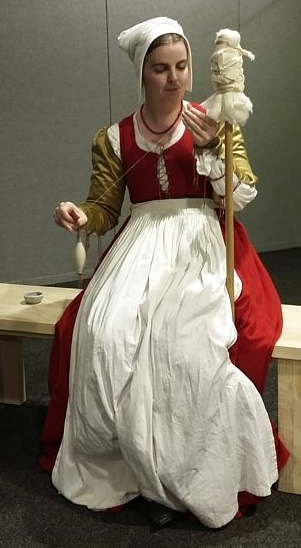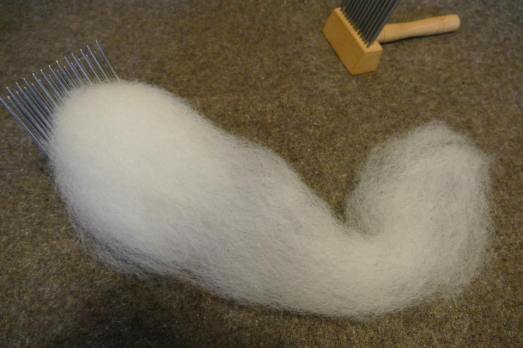Today I share a video of a lady showing others how to spin. Though I don’t speak Russian and the auto-translated captions aren’t quite up to the mark, I the close-ups of new spinners learning to twirl the spindle are still valuable.

Today I share a video of a lady showing others how to spin. Though I don’t speak Russian and the auto-translated captions aren’t quite up to the mark, I the close-ups of new spinners learning to twirl the spindle are still valuable.
There is a tradition in (I believe Bulgaria) where spinning and singing are combined. I don’t know anything about it and would like to learn more- i you know please comment!
Today I share a video that shows a clear view of the drafting hand. You can see that this wool is not as finley prepaired as the comercially combed top we find widley available today for handspinners. She appears to really need to tug down on the wool, and I think she is working at keeping her drafting up with the spindle. By this I mean the drafting, not her spindle or spinning technique is the time limiting factor.
This week I bring you the last of my reviews of Niddy Noddy’s Medieval Style Spindle Sticks. This one has a spiral notch.
Sorry I’ve been very lax with editing my spindle reviews.
This is my review of the first of the custom designed spindles Niddy Noddy made for me, THis one has no notch.
These spindles were re-shaped to fit my extant whorls below the ‘belly’ of the spindle, often spindle sticks are too thin to use these whorls.
This spindle has no notch, and next week I’ll post the video with a spiral notch.
So the facebook group on distaff spinning is called The Evangelical Church of Distaff Spinning. It’s not a religious group at all, but has got its name from the fact that when people try and love spinning with a distaff they want to tell everyone about it. Sometimes people will say “I’m a new convert to distaff spinning!”
Today I would like to share a fabulous post by Josefin Waltin:
Learning New Things – Medieval Style Spinning
She has also posted a great youtube video that includes some slow motion segments.
She has lots of fantastic (non-medieval) spinning videos and some great blog posts on a variety of spinning and not-spinning topics.
Sharing Saturday is where I like to share work by other spinners or living historians. Often I find something I’d like to share, but if you have something you’d like me to share then please let me know If it’s on the internet I’ll like to it, if not I’m happy to post it direct to my blog (with credit).
A common sight in medieval manuscripts is ladies standing while spinning, like this lady spinning wool amongst the sheep.

Also common, is the lady taking a break to spin, like this lady spinning wool amongst the sheep.
Which sometimes raises the question “How do I use a distaff while sitting?”


Well, there are many answers and the right answer is what works for you.
This lady has a beautiful standing distaff.

Grabow Altarpiece, Bertram von Minden, c 1379-1383
Sometimes the lady clasps the distaff between her knees

1380, Mary spinning
I would love a standing distiff, but I don’t have one yet. People have asked how I sit with my distaff and as it’s hard to explain I decided to do a video.
This is simply how I sit with my distaff, what works for you may be different. Please feel free to share what works for you in the comments!

Tell a bunch of spinners that the output of a medieval spinner could be no more than 20 metres per hour, and they’ll want to prove you wrong. As such, the folks over at the Evangelical Church of Distaff Spinning are conducting a spinning experiment, looking at the production rates of modern spinners. The experiment collects a wide range of date, from spinning method, years of experience to fibre spun, tools used and more. Collecting all of this data means that we can use the results for different things. For example, we could compare grasped spinning production rates to that with suspended spinning, or we could look at how years of experience affects production.
I encourage you all to take part, here is the form you need to complete and you can take part multiple times.
When you are filling out the form, pay attention when it asks you to enter in the amount spun- just do that! There’s a slot for time spun also so your production rate per hour can be calculated. Don’t be clever and work out the average you spun in an hour, otherwise you’ll confuse the results:

Oops!
At least it gave me a laugh! The preliminary results (without my mistake) are up on the facebook group so if you’re not a member, join to check them out. But we need more responses, so please take part!

Today I thought I’d share how Jane dresses her distaff after she kindly posted step-by-step photos on the Historic Spinning facebook group. Many thanks to Jane Hunt for allowing me to share!
I hand comb the fibres with my mini combs.

Then I draw off the fibres by hand, not having a clamp means I can’t use a diz, but maybe one day.

Next I plank the sliver, a fancy term for breaking it into suitable lengths for my distaff.

Then I spread out each length into a thin layer about 10″ wide.

I pile up the layers, one on top of the other, to form a batt.

Then I lay my distaff along the long edge (the same direction that the fibres are going in) As you can see, this is my deluxe ‘from the hedgerow’ distaff!

I then roll the distaff up in the batt fairly snugly.

Finally I criss cross my linen tape down the distaff and tie in a bow at the bottom. I tie it tight enough for there to be some resistance to pull against, but not so tight I can’t draught the fibres comfortably. Hope this helps!

How do you dress your distaff? Please do share your methods, and let me know if you’d like me to post your method on my blog for another Sharing Saturday.
You can read about some other distaff dressing methods here.